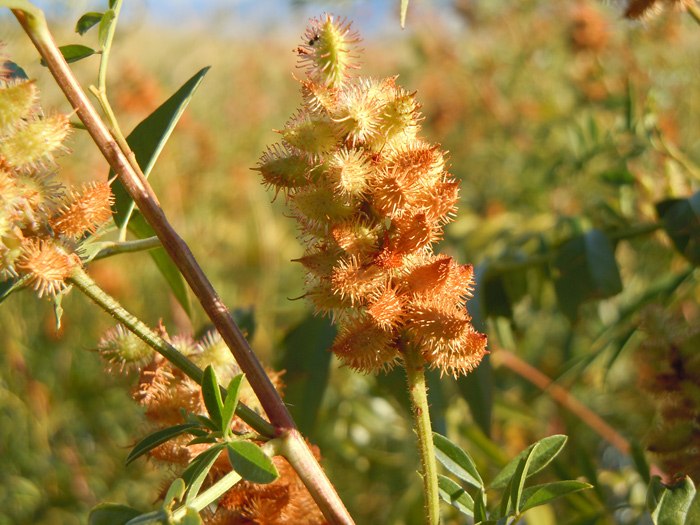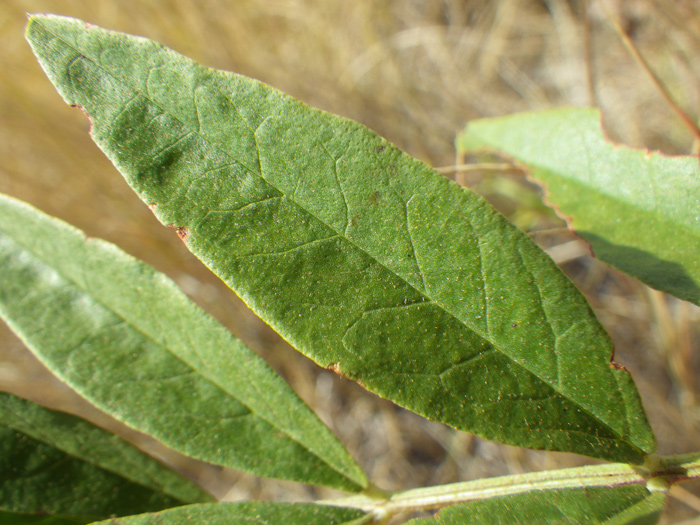Wild Licorice
- Glycyrrhiza lepidota Pursh
- Bean family (Fabaceae)
Narration:
General Information
- Plants: Perennial herbs less than 4 feet tall forming dense colonies. Leaves pinnately compound with nine to nineteen leaflets with needle-like tips; arranged in opposite pairs.
- Flowers: White or yellowish with a slight tinge of purple; arranged in dense, spikelike racemes.
- Fruits: Pods covered with hooked prickles.
- Flowering Season: May to July.
- Habitat/Range: Streambanks, swales, and ravines from Ontario to British Columbia and south to Arkansas and southern California.1
Blackfeet Ethnobotany*
by Darnell and Smokey Rides At The Door
The Blackfeet name for wild licorice is A Ah So Waa. It translates as 'to grab' or 'to seize,' derived from the way that the burrs of the plant cling to the skirts of the gatherer. Medicinally, wild licorice is traditionally used by the Blackfeet as an infusion to treat chest pains, swellings, coughs, and sore throats.
The plant also was used as a brush to clean teeth and refresh breath. The roots of wild licorice were fed to horses to improve stamina. The burrs of the plant were used by buffalo runners to prevent thirst.2
From the Journals
by H. Wayne Phillips
A wild-licorice specimen does not exist in the extant Lewis and Clark Herbarium, and we have no evidence that they ever collected one, but Lewis and Clark did mention it several times in the journals.3 On May 8, 1805, near the mouth of the present-day Milk River in Montana, Meriwether Lewis wrote: "The wild Licquorice is found on the sides of these hills, in great abundance." On the same day, William Clark noted that while walking with Charbonneau and Sacagawea, his wife, she spent time gathering wild licorice and white apples.
On January 24, 1806, while at Fort Clatsop in Oregon, Lewis wrote:
I observe no difference between the licorice of this Countrey and that Common to maney parts of the United States where it is sometimes Cultivated in our gardens. . . . the nativs roste it in the embers and pound it Slightly with a Small Stick in order to make it Seperate more readily from the Strong liggaments which forms the center of the root. . . . This root when roasted possesses an agreeable flavour not unlike the Sweet potato.
Given Lewis’s knowledge of plants and powers of observation, it is likely that this journal entry refers to the taller wild licorice and not the low-growing Chinook licorice (Lupinus littoralis), which also grows near Fort Clatsop.4
Additional Information: Because this flower is a legume, it restores nitrogen to the soil. Different species of wild licorice exist globally, and historically has been used medicinally as far back as ancient times in many cultures.5 The roots contain a substance known as glycyrrhizin, which is used in modern pharmaceuticals but also sweetener in some food products. The seeds of wild licorice plants have small hooks that are able to attach and eventually fall off of animals, aiding in seed dispersion.6
*While traditional medicine is still practiced in many cultures including the Blackfeet culture and has many uses, please do not consume any plant material without consultation of a health professional.

South of Malta, Montana. © 2006 by Jacopo Werther. Permission to use granted under the Creative Commons Attribution-ShareAlike 2.0 Generic (CC-BY-SA 2.0) license.

Bozeman, Montana. © 2010 by Matt Lavin. Permission to use granted under the Creative Commons Attribution-ShareAlike 2.0 Generic (CC-BY-SA 2.0) license.

Bozeman, Montana. © 2012 by Matt Lavin. Permission to use granted under the Creative Commons Attribution-ShareAlike 2.0 Generic (CC-BY-SA 2.0) license.
Notes
- "Glycyrrhiza lepidota, Pursh" United States Department of Agriculture Natural Resources Conservation Service Plant Database, plants.usda.gov/home/plantProfile?symbol=GLLE3.
- All ethnobotanical information was given or verified by Smokey Rides At The Door and Darnell Rides At The Door. Initial research came from Native American Ethnobotany Database. Please be advised that not all studies included are correct and to consult with Native community members to verify information.
- H. Wayne Phillips, Plants of the Lewis and Clark Expedition (Missoula, Montana: Mountain Press Publishing Company, 2003). H. Wayne Phillips graciously donated his expertise on this subject by writing this narrative.
- The Definitive Journals of Lewis & Clark, Gary Moulton, ed.
- "Fabaceae Glycyrrhiza lepidota," National Parks Service www.nps.gov/arch/learn/nature/fabaceae_glycyrrhiza_lepidota.htm.
- "Species: Glycyrrhiza lepidota," United States Department of Agriculture Fire Effects Information System, www.fs.usda.gov/database/feis/plants/forb/glylep/all.html#BOTANICAL%20AND%20ECOLOGICAL%20CHARACTERISTICS.


